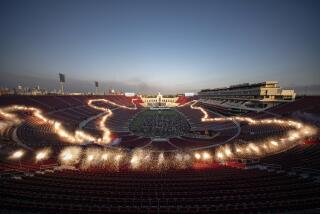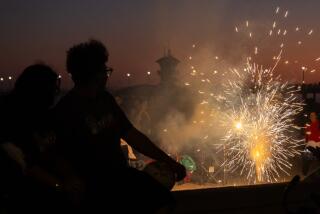Lomita Fireworks Ban Will Do Little to Muffle Holiday’s Bang
Since Lomita took the bang out of the Fourth of July by banning fireworks this year, non-explosive poppers, sparklers, smoke snakes and the like will be available in one less South Bay city.
Even so, area police and fire officials do not expect a substantial decrease in fireworks use.
“Fireworks have become a traditional thing to do, and the fact that they are illegal in one area and not in another doesn’t seem to stop people from using them,” said Battalion Chief Jim Daleo of Los Angeles County’s Fire Prevention Unit.
Explosive fireworks, including firecrackers, bottle rockets and Roman candles, are illegal throughout the state, but cities can pass measures to allow the sale and use of so-called “safe and sane” fireworks.
Four South Bay cities--Carson, Hawthorne, Inglewood and Lawndale--permit the sale of non-explosive fireworks during the holiday week. “Safe and sane” fireworks, so called because they emit noise and sparks but do not actually explode, are sold at street stands in those cities by nonprofit organizations such as church groups, the Elks Club and Little League organizations.
Until this year, nonprofit organizations in Lomita have operated seven to 12 fireworks stands each year. But frequent complaints about noise and fire hazards prompted city officials to put the fireworks issue before the voters. An advisory ballot measure to ban fireworks sales passed by a margin of 49 votes out of 1,027 cast during the April 8 election, and the City Council banned them soon afterward.
The fireworks ban will probably translate into large financial losses for the nonprofit organizations that in the past collectively averaged $100,000 a year from fireworks sales.
“We earned thousands of dollars from fireworks sales,” said Bill Cook, commander of VFW Post 1622 in Lomita. “I guess we’ll have to reorganize, but I doubt we’ll ever find another program that brings in the kind of money that fireworks did.”
Fireworks sales bring in a total of about $400,000 for nonprofit organizations in the four cities that still permit the use and sale of “safe and sane” pyrotechnics. “Nonprofit groups earn all kinds of money that allow them to do things they wouldn’t normally be able to afford,” said Hawthorne city spokesman Tom Quintana. “Here in Hawthorne, fireworks sales don’t cause a problem; in fact, they (do) a lot of good,” Quintana said, referring to nonprofit services supported by fireworks revenue.
In addition to helping nonprofit groups, the sale of fireworks gives cities a cut of the revenue, which helps fund safety and fire prevention programs. “There is always some risk to playing with something that requires matches, but in our case the benefits far outweigh the risks,” said Bonnie Strojny, of Inglewood’s finance department. “If fireworks sales stopped, so would many of the city’s fire safety programs.”
All four South Bay cities that allow the sale and use of fireworks stipulate that customers must be 16 or older, and they discourage customers from taking the fireworks into areas where their use is illegal.
Lomita city officials have posted signs in city parks and are running public service notices on local cable television to remind residents that the use of fireworks in Lomita is now a misdemeanor punishable by a fine of $500 to $1000 or up to one year in jail.
But city officials, noting that “old habits are hard to break,” say Lomita residents might drive to nearby Carson or other cities to get their fireworks fix.
“I don’t think it is going to be a big problem, but I suspect that there are people who have become so accustomed to fireworks that they’ll get them from somewhere else now,” said Lomita City Manager Walker Ritter.
Indeed, police and fire officials from throughout the South Bay are expecting to see fireworks regardless of whether the particular city allows the use or sale of the non-explosive pyrotechnics.
“Fireworks are a symbol of the Fourth of July . . . and as long as they are available, people are going to buy them even if they have to drive an extra mile or two,” said Lt. Bruce Powell of the Manhattan Beach Police Department.
“The Fourth is the busiest day at the beach. The holiday that is supposed to be a day for national celebration can be a real nervous time for police and fire officials trying to control the use of fireworks.”
Last year fireworks were responsible for two fires in Manhattan Beach and four more in Hermosa Beach and Redondo Beach.
Though no figures were available for other South Bay cities, state statistics show that fireworks were responsible for 258 fires in Los Angeles County in 1985--up from 186 the previous year. County fire officials estimate that about a third of those fires were started by legal fireworks.
To make sure that the “safe and sane” fireworks are just that, officials in cities that allow them are taking additional precautions this year by distributing a fireworks safety bulletin with each sale.
The bulletin, which includes tips from the state fire marshal’s office, suggests that customers use fireworks outside in a clear area away from dry grass and combustible materials, keep a bucket of water nearby for smoldering debris, do not relight fireworks that malfunction and avoid placing fireworks in glass or metal containers.
More to Read
Sign up for Essential California
The most important California stories and recommendations in your inbox every morning.
You may occasionally receive promotional content from the Los Angeles Times.










